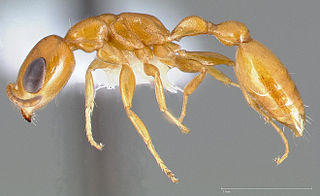
Pseudomyrmecinae is a small subfamily of ants containing only three genera of slender, large-eyed arboreal ants, predominantly tropical or subtropical in distribution. In the course of adapting to arboreal conditions, the pseudomyrmecines diversified and came to occupy and retain a much wider geographic range.

Formica pratensis, the black-backed meadow ant, is a species of European red wood ant in the family Formicidae.

Pseudomyrmex is a genus of stinging, wasp-like ants in the subfamily Pseudomyrmecinae. They are large-eyed, slender ants, found mainly in tropical and subtropical regions of the New World.

Pseudomyrmex gracilis, also known as the graceful twig ant, Mexican twig ant, slender twig ant, or elongated twig ant, is a large, slender species native to Mexico and arid parts of the US. The workers are about 8–10 millimeters (0.31–0.39 in) in length and generally wasp-like in appearance and style of movement. Worker ants are bi-colored; the head and gaster are dark, while the antennae, mouthparts, thorax and legs are dull orange with dark shading. They often may be seen on vegetation, foraging for live insects or collecting honeydew from sap-sucking insects.

Pseudomyrmex pallidus is a species of ant found in the Nearctic realm with an extensive range throughout the southern United States to Central America.
BugGuide is a website and online community of naturalists, both amateur and professional, who share observations of arthropods such as insects, spiders, and other related creatures. The website consists of informational guide pages and many thousands of photographs of arthropods from the United States and Canada which are used for identification and research. The non-commercial site is hosted by the Iowa State University Department of Entomology. BugGuide was conceived by photographer Troy Bartlett in 2003 and since 2006 has been maintained by John VanDyk, an adjunct assistant professor of entomology and a senior systems analyst at Iowa State University. The website has been recognized for helping change the public perception of insects.
Avitomyrmex is an extinct genus of bulldog ants in the subfamily Myrmeciinae which contains three described species. The genus was described in 2006 from Ypresian stage deposits of British Columbia, Canada. Almost all the specimens collected are queens, with an exception of a single fossilised worker. These ants are large, and the eyes are also large and well-developed; a sting is present in one species. The behaviour of these ants may have been similar to extant Myrmeciinae ants, such as foraging solitarily for arthropod prey and never leaving pheromone trails to food sources. Avitomyrmex has not been assigned to any tribe, instead generally being regarded as incertae sedis within Myrmeciinae. However, its identity as an ant has been challenged, although it is undoubtedly a hymenopteran insect.
Pseudomyrmex triplarinus is a venomous species of ant that lives in symbiosis with trees of the genus Triplaris, including the South American species T. americana, T. cumingiama, and T. felipensis. The ant protects the trees against predation by other insects and animals. The ant's venom has anti-inflammatory properties.

Pseudomyrmex simplex is a species of ant in the family Formicidae.

Pseudomyrmex ejectus is a species of ant in the family Formicidae.

Pseudomyrmex apache is a species of ant in the family Formicidae.

Pseudomyrmex cubaensis is a species of ant in the family Formicidae.

Crematogaster hespera is a species of ant in the family Formicidae.

Pheidole californica is an ant, a species of higher myrmicine in the family Formicidae.
Hamotus elongatus is a species of ant-loving beetle in the family Staphylinidae.
Mitostylus is a genus of broad-nosed weevils in the beetle family Curculionidae. There are about seven described species in Mitostylus.

Pseudomyrmex seminole is a species of ant in the family Formicidae.
Mitostylus elongatus is a species of broad-nosed weevil in the beetle family Curculionidae. It is found in North America.
Anthonomus elongatus is a species of true weevil in the beetle family Curculionidae. It is found in North America.












